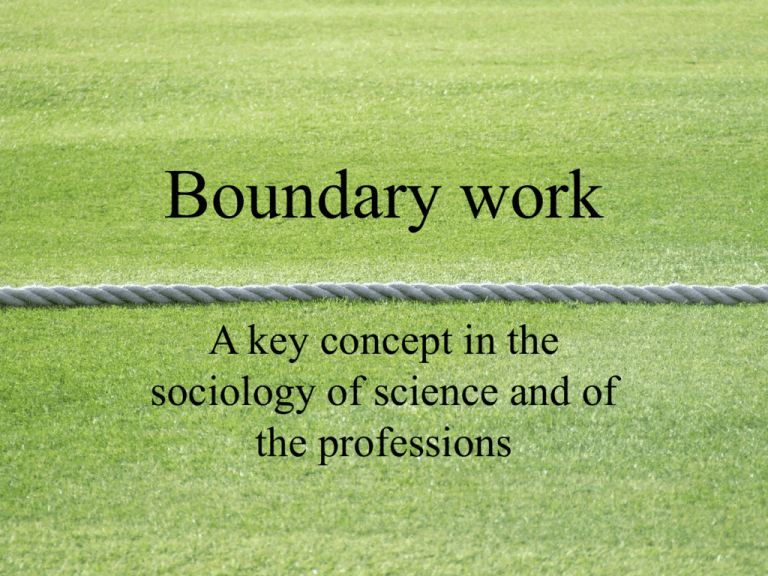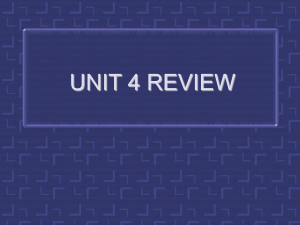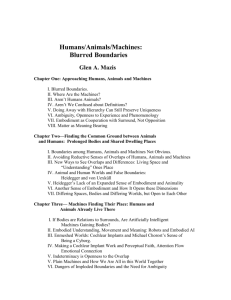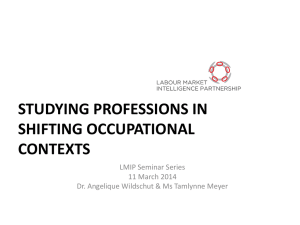BoundaryW - Elise Paradis
advertisement

Boundary work A key concept in the sociology of science and of the professions j.mp/BoundaryW What are boundaries? Power differential between groups of people: e.g. professions Overlap. Boundaries are something that can be crossed; regulated; described. E.g. patient/care provider; teacher/learner Barriers. E.g. something that is regulated, through criteria They are fundamental to the study of social processes. They are at the centre of a wide range of research on: – Class, ethnic/racial, sex/gender inequality; They are at the centre of a wide range of research on: – Class, ethnic/racial, sex/gender inequality; – Communities, national identities; They are at the centre of a wide range of research on: – Class, ethnic/racial, sex/gender inequality; – Communities, national identities; – The professions, science and knowledge. Lamont and Molnár (2002) defined two types of boundaries: social and symbolic. Social boundaries “objectified forms of social difference,” widely-agreed-upon boundaries between people (p. 168). e.g. teacher/learner; patient/provider; gender boundaries: take different forms; parent/child; race; police/public. Lamont and Molnár (2002) The study of boundaries in the social sciences. Annual Review of Sociology. 28: 167-95. Symbolic boundaries “conceptual distinctions made by social actors to categorize objects, people, practices, and even time and space” (p. 168). e.g. brands; clothing; accents; class; body weight; health Lamont and Molnár (2002) The study of boundaries in the social sciences. Annual Review of Sociology. 28: 167-95. Symbolic boundaries “conceptual distinctions made by social actors to categorize objects, people, practices, and even time and space” (p. 168). e.g. Urban; Competent; Lamont and Molnár (2002) The study of boundaries in the social sciences. Annual Review of Sociology. 28: 167-95. Why do boundaries matter? Protectionism: Arctic sovereignty; Structuration of society: useful (harmful) Desire to categorize: cognitive shortcut. Making sense of the world Boundaries are relational: they define us against them, me and mine against the world. They create, reproduce and change hierarchies between groups of people, and thus partly determine the trajectory of individuals in society through allocation of resources. They are cultural, constructed. They are not set in stone, but the process of conscious and subconscious determination. They are thus arbitrary and changeable. Boundary work What could “boundary work” mean? Determination of what falls within a boundary/group I agree! Stratification. Work that is involved in crossing boundaries; movement around the boundary Exploring the interface of boundaries Deciding what is legitimate and illegitimate Difference between interstitial and boundary work? 1995 referendum: fight for several boundaries “Boundary work” was initially used in the context of scientific knowledge production (Gieryn. 1983). Gieryn (1983) Science has no fixed set of characteristics. Rather, it is the result of scientists’ discursive positioning of what they do as special, distinct from what others do. Boundary work Instances in which boundaries between fields of knowledge are created, advocated, attacked or reinforced. Boundary work helps actors do three things: Boundary work helps actors do three things: – Expand their authority over new domains; Boundary work helps actors do three things: – Expand their authority over new domains; – It monopolizes authority and resources; Boundary work helps actors do three things: – Expand their authority over new domains; – It monopolizes authority and resources; – It protects professional autonomy against encroachments by outsiders. The concept has been borrowed and applied in a wide variety of ways in healthcare research. Boundary work Instances in which boundaries between the professions or professionals are created, advocated, attacked or reinforced. Can we think of examples of boundary work in pharmacy? In the way pharmacists do and define science? In pharmacy practice? Surgeons vs anesthesiologists: relative contribution to final product; expertise. Pharmacists can now vaccinate; they have moved the boundary (but they are still limited in which types of vaccines) ?Creating a structure within admin databases 1. Boundaries - Can be social or symbolic; Are fundamental to social life; Are constructed and arbitrary; Matter because they determine access to resources. 2. Boundary work - - Was initially introduced to talk about the rhetorical demarcation of science from pseudoscience; Was brought to healthcare through the study of the professions; Is a helpful analytic lens to think about the dynamics between the professions and professionals today. Boundary work A key concept in the sociology of science and of the professions j.mp/BoundaryW To learn more (science) Albert, M. et al. 2009. Boundary-work in the health research field: Biomedical and clinician scientists’ perceptions of social science research. Minerva. 47:171-94. Gieryn, T. 1983. Boundary-work and the demarcation of science from non-science: Strains and interests in professional ideologies of scientists. American Sociological Review. 48:781-95. Lamont, M. & V. Molnár (2002) The study of boundaries in the social sciences. Annual Review of Sociology. 28:167-95. Shackley, S. & B. Wynne. 1996 Representing uncertainty in global climate change science and policy: Boundaryordering devices and authority. Science, Technology & Human Values. 21:275-302. To learn more (professions) Allen, D. (2000). Doing occupational demarcation: The “boundary-work” of nurse managers in a district general hospital. Journal of Contemporary Ethnography. 29:326356. Mesler, MA. 1991. Boundary encroachment and task delegation: clinical pharmacists on the medical team. Sociology of Health & Illness. 13:310-31. Mizrachi, N. & J. Shuval. 2005. Between formal and enacted policy: Changing the contours of boundaries. Social Science & Medicine. 60:1649-60. Owens, K. 2015. Boundary objects in complementary and alternative medicine: Acupuncture versus Christian science. Social Science & Medicine 128:18-24.




